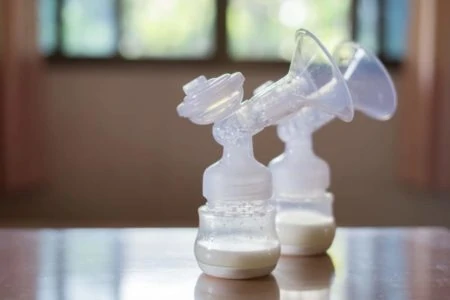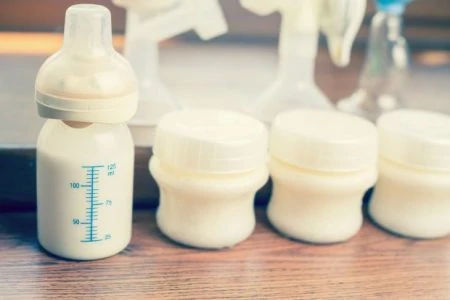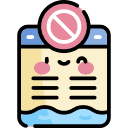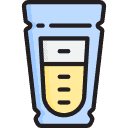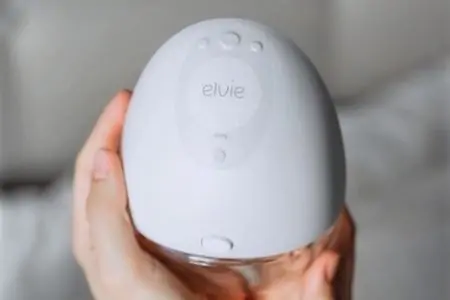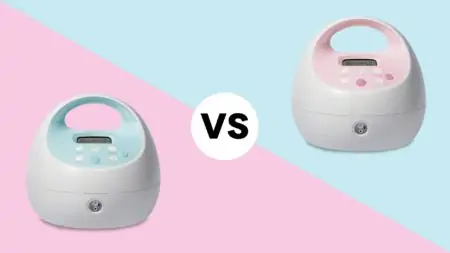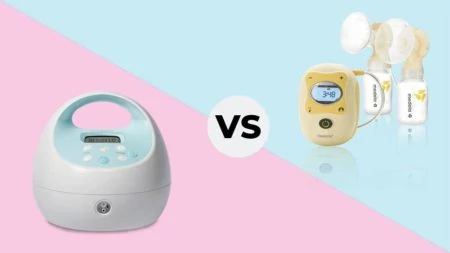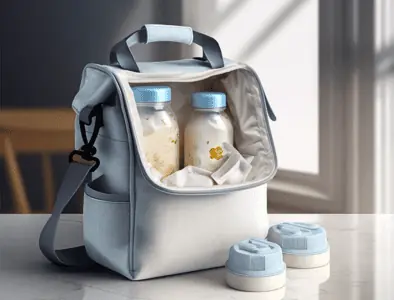For breastfeeding moms, a breast pump is a trusted ally. It lets you build a freezer stash, relieves uncomfortable engorgement, and helps maintain your supply when you’re away from your baby.
But buying the best breast pump is just the first step. You also need to know how to use it efficiently to maximize every drop of liquid gold.
In this guide, we break down the best times to pump, how to find the perfect fit, and answer the most pressing questions about expressing milk.
Key Takeaways
- Timing is everything: Occasional pumpers get the most milk in the morning; exclusive pumpers should stick to a schedule of every 2.5 to 3 hours.
- Gear matters: Manual pumps are great for travel and occasional relief, while double electric pumps are best for daily use and building a stash.
- Size correctly: Flange fit depends on nipple diameter, not breast size; a poor fit can cause pain and reduce milk output.
- Hygiene first: Wash hands before handling gear and clean pump parts thoroughly with hot, soapy water after every use.
Best Times to Pump Breast Milk
Timing can make a huge difference in your output. If you usually nurse your baby and only pump milk occasionally, try pumping in the morning. Your prolactin levels are naturally higher then, meaning you are likely to get the most volume.
For the best results, space breastfeeding and pumping sessions about an hour apart. You can pump an hour before you expect your baby to be hungry or an hour after a feed. This buffer gives your body enough time to replenish for the next session (1).
If you are exclusively pumping and not nursing at the breast, consistency is key. Aim to pump every 2.5 to 3 hours. Efficiently emptying your breasts frequently signals your body to keep production high.
How to Use a Breast Pump Properly
The technique you use depends heavily on whether you are using a manual silicone catcher, a hand pump, or an electric unit.
Manual pumps are affordable, quiet, and portable. However, because you supply the power, they take more effort. You can typically only express one side at a time, making it a slower process. We recommend manual pumps for occasional use or travel.
Moms who pump daily will benefit from a double electric pump. These allow you to pump both breasts simultaneously, saving time and saving your hands from cramping. While more expensive, the efficiency is usually worth the investment for working moms.
Using a Manual Breast Pump
Follow these steps to get a rhythm going with a hand pump:
- Trigger let-down: Milk doesn’t always flow instantly. Gently massage your breasts or apply a warm washcloth to encourage the milk to release.
- Seal it: Center your nipple in the breast shield (flange) and ensure it creates an airtight seal against your skin.
- Start pumping: Squeeze the handle rhythmically. Start fast to mimic a baby stimulating flow, then slow down once milk appears.
- Use gravity: If the flow is slow, lean forward slightly to let gravity help the milk travel into the bottle.
- Switch sides: Continue until the flow slows down, then switch to the other breast.
Using an Electric Breast Pump
Electric pumps do the heavy lifting for you; here is how to operate them:
- Get set up: Center your nipples in the flanges and hold them consistently against your breasts.
- Power on: Start the machine on the “stimulation” phase (fast and light) if your pump has one.
- Adjust suction: Once milk flows, switch to the expression phase. Turn the suction up to the highest level that is still comfortable. Pain inhibits milk flow, so do not torture yourself.
- Finish up: When the milk stops spraying and turns to slow drips, turn off the machine. Break the suction seal with your finger before pulling the flange away.
Essential Pumping Tips
Keep these safety and comfort rules in mind every time you express milk:
- Hygiene is non-negotiable: Always wash your hands before handling pump parts or your breasts to prevent contamination.
- Patience is key: Milk flow isn’t like a faucet; it may take a minute or two of suction to trigger the let-down reflex.
- Protect your nipples: Never rip the suction cup off while the pump is running. Turn it off and slide a finger under the rim to break the vacuum gently.
Finding the Right Breast Shield Size
Breast shields, also known as flanges, are the funnels that fit over your breast. Using the wrong size is the number one cause of pumping pain and low output.
Critically, you must choose a shield based on your nipple size, not your breast size (cup size). Flange sizes vary by brand, and your nipple size can actually change throughout your breastfeeding journey.
When Size Matters
If pumping hurts rather than just feeling like a firm tug, stop immediately. Re-measure your nipples and try a different flange size.
Cleaning and Hygiene Best Practices
Pumps have many nooks and crannies where bacteria can hide. Always refer to your specific manufacturer’s cleaning instructions, but general rules apply to most models.
Rinse parts that touch breast milk in cool water immediately after use to remove protein buildup. Then, wash them in hot, soapy water. Many modern pump parts are top-rack dishwasher safe, but check the manual first (2).
Always let parts air dry completely on a clean paper towel or drying rack. Moisture traps bacteria, so ensure everything is bone-dry before reassembling. You can also use a baby bottle sterilizer or microwave steam bags for a deeper clean once a day.
Daily Hygiene Checklist
Follow these habits to keep your milk stash safe and your body healthy:
- Avoid applying scented lotions or creams directly to the nipples prior to pumping.
- Change your nursing pads immediately if they get damp to prevent yeast infections.
- Wear breathable, natural fabrics like cotton to keep the breast area dry.
- Wash your nursing bra frequently.
- Scrub your hands for 20 seconds before every pumping session.
- Rinse pump parts immediately; do not let milk dry and crust inside the valves.
- Wipe down the pump motor/base (the part that doesn’t touch milk) with a disinfectant wipe occasionally.
- Rinse your nipples with warm water daily; avoid harsh soaps that dry out the skin.
How to Boost Your Milk Supply
Your breasts operate on a supply-and-demand feedback loop. If you empty the milk, your body rushes to make more. If milk sits in the breast, production slows down.
To increase your stash, you must remove milk frequently and fully (3). Do not “save” milk for later; draining the breast is the only way to signal your body to ramp up production.
Even if you aren’t feeding the baby immediately, keep pumping. This tells your body that the baby is hungry and needs more fuel. It takes time, but your body will adjust to the new demand. If you have extra, freeze it for a rainy day.
Troubleshooting Low Supply
If your baby is gaining weight and has plenty of wet diapers, your supply is likely fine (4). However, if you need a boost, try these tactics:
- Check the latch: A baby transfers milk better than any pump. Ensure they are latching deeply and swallowing effectively.
- Power pump: Dedicate an hour to pump for 20 minutes, rest for 10, pump for 10, rest for 10, and pump for 10. This mimics a cluster-feeding baby.
- Frequency over duration: It is better to pump for 15 minutes every 3 hours than for 45 minutes twice a day.
- Consider galactagogues: Certain foods like oatmeal or supplements may help increase milk supply. Consult your doctor first.
- Hands-on pumping: Massage your breasts while pumping to help empty the ducts completely.
- Hydrate and rest: You cannot make liquid gold if you are dehydrated. Drink to thirst and eat a balanced diet.
